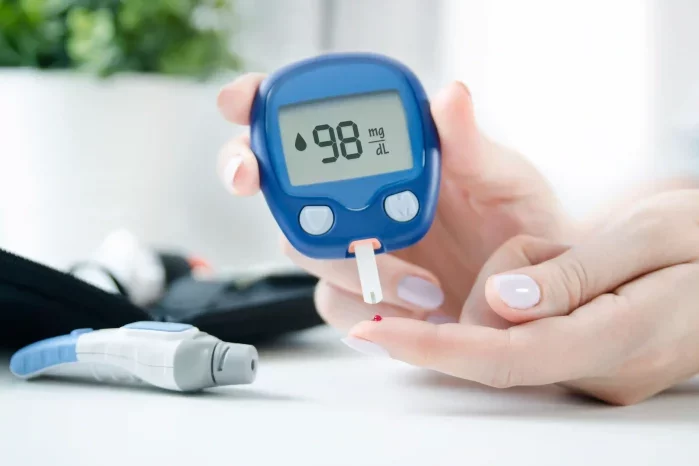Diabetes is a chronic metabolic disorder characterized by elevated blood sugar levels (hyperglycemia) resulting from defects in insulin secretion, insulin action, or both. Insulin, produced by the pancreas, is a hormone that helps regulate blood sugar (glucose) levels by facilitating the uptake of glucose into cells to be used as energy. When insulin function is impaired, glucose accumulates in the bloodstream, leading to high blood sugar levels over time. This comprehensive article explores the definition of diabetes, its types, causes, symptoms, diagnosis, treatment options, and management strategies.
Understanding Diabetes: Definition and Basics
Definition of Diabetes
Diabetes mellitus, commonly referred to as diabetes, encompasses a group of metabolic diseases characterized by high blood sugar levels over a prolonged period. The underlying mechanisms vary depending on the specific type of diabetes and may involve inadequate insulin production, resistance to insulin action, or both.
Insulin and Blood Sugar Regulation
Insulin plays a crucial role in blood sugar regulation by facilitating the uptake of glucose from the bloodstream into cells, particularly muscle, fat, and liver cells. This process allows cells to use glucose as a primary source of energy. In individuals with diabetes, either the pancreas fails to produce sufficient insulin (insulin deficiency) or the body becomes resistant to the effects of insulin (insulin resistance), leading to elevated blood sugar levels.
Types of Diabetes
There are several types of diabetes, each with distinct causes, characteristics, and treatment approaches. The primary types include:
- Type 1 Diabetes
- Type 2 Diabetes
- Gestational Diabetes
- Other Specific Types of Diabetes
Let’s explore each type in detail:
1. Type 1 Diabetes
Type 1 diabetes is an autoimmune condition characterized by the immune system mistakenly attacking and destroying insulin-producing beta cells in the pancreas. As a result, the pancreas produces little to no insulin, leading to a dependence on exogenous insulin (insulin injections) for survival.
Causes of Type 1 Diabetes
The exact cause of type 1 diabetes is not fully understood, but genetic predisposition and environmental factors, such as viral infections, may play a role in triggering autoimmune destruction of beta cells.
Symptoms of Type 1 Diabetes
- Excessive thirst (polydipsia)
- Frequent urination (polyuria)
- Increased hunger (polyphagia)
- Unexplained weight loss
- Fatigue and weakness
Diagnosis and Treatment of Type 1 Diabetes
Type 1 diabetes is typically diagnosed in children, adolescents, and young adults. Diagnosis involves blood tests to measure blood sugar levels and autoantibodies associated with autoimmune destruction of beta cells. Treatment requires lifelong insulin therapy, blood sugar monitoring, a balanced diet, regular physical activity, and ongoing medical supervision to manage blood sugar levels effectively and prevent complications.
2. Type 2 Diabetes
Type 2 diabetes is the most common form of diabetes, accounting for the majority of cases worldwide. In type 2 diabetes, the body either becomes resistant to the effects of insulin or the pancreas fails to produce enough insulin to maintain normal blood sugar levels.
Causes of Type 2 Diabetes
Type 2 diabetes is influenced by genetic factors and lifestyle choices, including:
- Obesity
- Physical inactivity
- Unhealthy diet
- Aging
- Family history of diabetes
Symptoms of Type 2 Diabetes
- Increased thirst
- Frequent urination
- Increased hunger
- Fatigue
- Blurred vision
- Slow wound healing
- Tingling or numbness in hands or feet
Diagnosis and Treatment of Type 2 Diabetes
Type 2 diabetes is often diagnosed in adults, but it is increasingly seen in younger individuals due to rising rates of obesity and sedentary lifestyles. Diagnosis involves blood tests to measure fasting blood sugar levels, oral glucose tolerance tests, or HbA1c tests (glycated hemoglobin) to assess long-term blood sugar control. Treatment strategies include lifestyle modifications (diet, exercise), oral medications to improve insulin sensitivity or promote insulin production, and, in some cases, insulin therapy. Regular monitoring of blood sugar levels, blood pressure, and cholesterol levels is essential to manage type 2 diabetes and prevent complications.
3. Gestational Diabetes
Gestational diabetes develops during pregnancy and affects about 2-10% of pregnancies worldwide. It is characterized by elevated blood sugar levels that typically resolve after childbirth but can increase the risk of complications for both the mother and baby if not managed effectively.
Causes of Gestational Diabetes
Gestational diabetes occurs when pregnancy hormones interfere with insulin action, leading to insulin resistance. Women with pre-existing risk factors, such as obesity or a family history of diabetes, are more likely to develop gestational diabetes.
Symptoms of Gestational Diabetes
Gestational diabetes often does not cause noticeable symptoms. However, some women may experience:
- Increased thirst
- Frequent urination
- Fatigue
- Blurred vision
Diagnosis and Treatment of Gestational Diabetes
Gestational diabetes is diagnosed through prenatal screening tests, such as glucose challenge tests or oral glucose tolerance tests. Treatment focuses on managing blood sugar levels through diet, physical activity, and, in some cases, insulin therapy to reduce the risk of complications for both mother and baby. Close monitoring by healthcare providers during pregnancy is essential to ensure optimal maternal and fetal health outcomes.
4. Other Specific Types of Diabetes
In addition to the main types of diabetes discussed above, there are several other specific types that result from genetic mutations, diseases of the pancreas, medication-induced diabetes, or other medical conditions. These include:
- Monogenic Diabetes (Maturity-Onset Diabetes of the Young – MODY)
- Cystic Fibrosis-related Diabetes
- Drug or Chemical-induced Diabetes
- Diabetes due to Genetic Syndromes
- Pancreatic Diseases (e.g., pancreatitis, pancreatic cancer)
Each specific type of diabetes requires tailored treatment approaches based on its underlying cause and associated health considerations.
Risk Factors for Diabetes
Several risk factors increase the likelihood of developing diabetes. These include:
- Family history: Having a parent or sibling with diabetes increases your risk.
- Obesity: Excess body weight, especially abdominal fat, increases insulin resistance.
- Physical inactivity: Lack of regular exercise decreases insulin sensitivity.
- Age: The risk of type 2 diabetes increases with age, especially after age 45.
- Race and ethnicity: Certain ethnic groups, including African Americans, Hispanic/Latino Americans, Native Americans, and Asian Americans, have a higher risk of developing diabetes.
- Gestational diabetes: Women who have had gestational diabetes or gave birth to a baby weighing more than 9 pounds are at increased risk of developing type 2 diabetes later in life.
- Polycystic ovary syndrome (PCOS): Women with PCOS are at higher risk of developing insulin resistance and diabetes.
- High blood pressure: Hypertension is a risk factor for type 2 diabetes.
- High cholesterol: Abnormal cholesterol levels, particularly high triglycerides and low HDL cholesterol, increase the risk of diabetes.
Understanding these risk factors can help individuals assess their risk of developing diabetes and take proactive steps to prevent or manage the condition.
Complications of Diabetes
Poorly controlled diabetes can lead to serious health complications over time, affecting various organs and systems in the body. Common complications include:
- Cardiovascular disease: Diabetes increases the risk of heart disease, stroke, and peripheral artery disease.
- Kidney disease (diabetic nephropathy): High blood sugar levels can damage the kidneys’ filtering units, leading to kidney failure.
- Eye damage (diabetic retinopathy): Diabetes can cause damage to the blood vessels in the retina, leading to vision impairment and blindness.
- Nerve damage (diabetic neuropathy): Diabetes can damage the nerves throughout the body, causing pain, numbness, and tingling, particularly in the hands and feet.
- Foot damage: Poor circulation and nerve damage increase the risk of foot ulcers, infections, and, in severe cases, amputation.
- Skin conditions: Diabetes increases the risk of skin infections, bacterial and fungal infections, and slow wound healing.
Managing blood sugar levels effectively and addressing risk factors can help reduce the risk of complications associated with diabetes. Regular medical screenings and consultations with healthcare providers are essential to monitor and manage diabetes-related complications.
Diabetes Management Strategies
Effective management of diabetes involves a multifaceted approach aimed at controlling blood sugar levels, preventing complications, and improving overall quality of life. Key strategies include:
Lifestyle Modifications
- Healthy diet: Follow a balanced meal plan rich in fruits, vegetables, whole grains, lean proteins, and healthy fats. Limit intake of refined sugars, saturated fats, and processed foods.
- Regular physical activity: Engage in at least 150 minutes of moderate-intensity aerobic exercise per week, such as brisk walking, swimming, or cycling.
- Weight management: Maintain a healthy weight through diet and exercise to improve insulin sensitivity and reduce the risk of complications.
Medication Therapy
- Oral medications: Depending on the type of diabetes and individual needs, oral medications may be prescribed to improve insulin sensitivity, promote insulin production, or reduce glucose production by the liver.
- Insulin therapy: For individuals with type 1 diabetes or advanced type 2 diabetes, insulin therapy is essential to regulate blood sugar levels effectively.
Blood Sugar Monitoring
- Self-monitoring: Regularly check blood sugar levels using a blood glucose meter to track daily fluctuations and trends. Adjust treatment plans based on monitoring results and healthcare provider recommendations.
- Continuous glucose monitoring (CGM): CGM systems provide real-time glucose readings throughout the day and night, offering valuable insights into blood sugar patterns and trends.
Healthcare Team Collaboration
- Regular medical appointments: Schedule routine visits with your healthcare provider, diabetes educator, and other specialists to assess blood sugar control, review treatment goals, and address any concerns or complications.
- Diabetes education: Participate in diabetes self-management education programs to learn about diabetes management strategies, healthy lifestyle habits, and coping techniques.
Emotional and Psychological Support
- Stress management: Practice relaxation techniques, mindfulness, or meditation to reduce stress levels, which can affect blood sugar control.
- Support networks: Seek support from family, friends, support groups, or mental health professionals to cope with the emotional and psychological aspects of living with diabetes.
Prevention Strategies
- Lifestyle modifications: Adopt healthy lifestyle habits, including regular exercise and a balanced diet, to reduce the risk of developing type 2 diabetes.
- Screening and early detection: Undergo regular medical screenings and tests to identify prediabetes or early-stage diabetes and take preventive measures.
See also: What Supplements Should Diabetics Avoid?
Conclusion
Diabetes is a complex metabolic disorder characterized by elevated blood sugar levels due to insulin deficiency, insulin resistance, or both. Understanding the different types of diabetes, their causes, symptoms, and management strategies is essential for effective diabetes care and prevention of complications. By adopting healthy lifestyle habits, monitoring blood sugar levels, adhering to prescribed treatments, and collaborating closely with healthcare providers, individuals with diabetes can achieve optimal blood sugar control and improve their overall quality of life. Empower yourself with knowledge, take proactive steps toward diabetes management, and prioritize your health through comprehensive care and support.
Related topics:
What’s the First Symptoms of Type 2 Diabetes


























